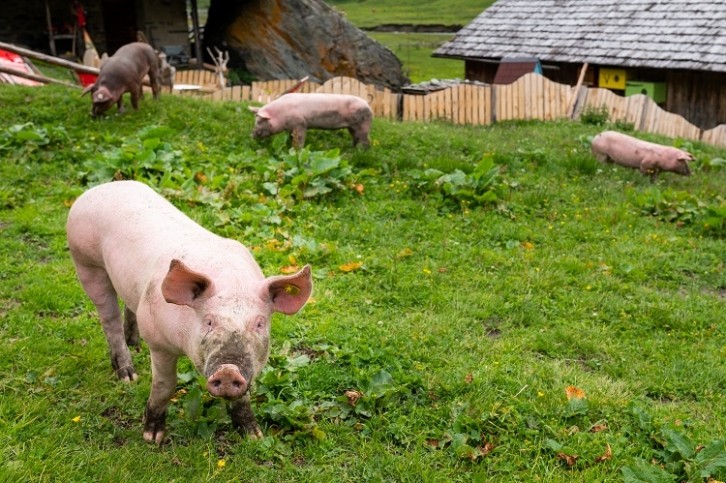Infectious disease outbreaks often threaten European animal supply chains. An outbreak of bovine spongiform encephalopathy (BSE) in the 1990s, for example, and foot-and-mouth disease (FMD) in 2001, brought into focus the need for the meat industry in Europe to control the animal trade and ensure that infectious diseases do not harm their livestock.
Pork, which is Austria’s most consumed meat (the average per person consumption of pork, as of 2021, was 34.2kg) has a particular potential to cause the spread of infectious disease.
The Austrian pig value chain is also threatened by ‘exotic’ diseases, such as African swine fever (ASF), classical swine fever (CSF), and FMD.
The study, published in the journal Scientific Reports, analysed how the pork industry linked up: the links between slaughterhouses, logistics posts and farms, and how they raised or reduced the risk of the spread of infectious disease. Slaughterhouses, however, were not included in the main analysis, because of their limited impact on infectious disease.
Topology of an industry
Collecting data about pork trades between January 2015 and December 2021, the study recorded 40,951 pig holdings and 1,917,584 movement records.
Austria has a remarkably self-contained pork industry, with few of the recorded journeys going outside of the country.
“The low level of pork export in Austria can be associated with the country’s self-sufficiency in pork production,” Gavrila A. Puspitarani, one of the study’s authors, told FoodNavigator.
 Pork is Austria’s most consumed meat. Image Source: Stefan Rotter/Getty Images
Pork is Austria’s most consumed meat. Image Source: Stefan Rotter/Getty Images
“The self-sufficiency rate of pork production is 103%, indicating that it produces enough to meet domestic demand. Additionally, only about 1 – 2% of pig movements were transferred overseas in a year, highlighting the limited volume of pork exported from Austria.”
Not only is the pork industry contained within Austria, but the research showed that movement was far more often within its states (91.6%) than between states (8.4%). Pigs don’t often travel far in Austria.
Most significantly, the study found that 62.9% of farms were very small, having four pigs or less. Conversely, large farms, which contained 2000 pigs or more, made up 0.25%. They found a high concentration of farms in Styria and Upper Austria.
For most of the study, activity between different parts of the supply chain trended downwards, with a slight uptick towards the end of the time period surveyed.
Disease potential
Of course, the big question is how this arrangement affects the likelihood of disease spreading throughout the pork supply chain.
In fact, suggested Puspitarani, it could be saved from disease by its lack of connectivity. “Based on our study, the Austrian pig trade network is not well-connected, which mean that the trade frequency between holdings is relatively low, and few long-range movements, indicating a limited spread of infectious disease during the outbreaks.
“However, the greatest risk arises in Upper Austria and Styria, as these regions account for nearly half (46%) of all holdings with significant trading activity. Moreover, there is a great proportion of closely linked holdings in these regions which makes them more vulnerable.”
The study identified several places with an abnormally high number of links to the rest of the supply chain, which it called ‘hubs’. These were the top 1% most connected “This means that the holdings in these areas are connected to many other holdings, which makes them a “good” spreader in spreading infectious diseases,” Puspitarani told us.
“So, if an infectious disease outbreak occurs in these regions, it might spread faster than in other federal states, where pig and farm density are much lower.”
While the hubs doubtless provide greater risk, the concentration of links in such limited places is, on the whole, a positive, lowering the total likelihood of infectious diseases across Austria’s overall supply chain.
“If the heterogeneity leans toward less concentrated and more dispersed farms, the likelihood of disease transmission and spread among animals is reduced,” Puspitarani told us.
“This reduction is due to the decreased proximity of animals from different farms, which limits the opportunities for direct or indirect contact that could facilitate disease transmission. Moreover, a lower density of animals in a given area may further decrease the risk of disease transmission. Therefore, a less heterogenous concentration of farms would likely reduce the likelihood of infectious diseases outbreak in the pig industry.”
 One of the biggest concentrations of pig farms was in Styria, Austria. Image Source: DieterMeyrl/Getty Images
One of the biggest concentrations of pig farms was in Styria, Austria. Image Source: DieterMeyrl/Getty Images
As well as proximity, the study found that temperature affected the spread of diseases, meaning taking seasonality into account is important for those in the pig industry.
Action for the future
While the results show that there is little potential for infectious disease in the supply chain overall, there are always ways that manufacturers could improve the system.
“Specifically, we can focus on regions with higher farm density and trading activity, such as Upper Austria and Styria, to implement targeted measures to reduce the vulnerability to infectious disease outbreaks,” Puspitarani suggested.
It isn’t just the issue of denser proximity in these regions that can be improved, however, but more general issues across the supply chain. “The pig industry may use our findings to enhance biosecurity practices and risk management strategies in highly connected premises to reduce their vulnerability.
“We highlighted that it is important to consider the presence of high-farm density and highly-connected pig holding, the seasonality of the network, presence of communities when designing infectious disease surveillance and disease control strategy.”
Sourced From: Scientific Reports
‘Network analysis of pig movement data as an epidemiological tool: an Austrian case study’
Published on: 14June 2023
DOI: https://doi.org/10.1038/s41598-023-36596-1
Authors: . G. A. Puspitarani, R. Fuchs, K. Fuchs, A. Ladinig & A. Desvars-Larrive
>>> Read full article>>>
Copyright for syndicated content belongs to the linked Source : FoodNavigator – https://www.foodnavigator.com/Article/2023/07/07/A-study-of-low-connectivity-The-risks-of-infectious-disease-in-Austria-s-pig-transportation-system?utm_source=RSS_Feed&utm_medium=RSS&utm_campaign=RSS














![[News] Japan Develops 10nm Nanoimprint Technology, with Potential to Tackle EUV Bottleneck – TrendForce](https://earth-news.info/wp-content/uploads/2025/12/329851-news-japan-develops-10nm-nanoimprint-technology-with-potential-to-tackle-euv-bottleneck-trendforce-360x180.jpg)
















